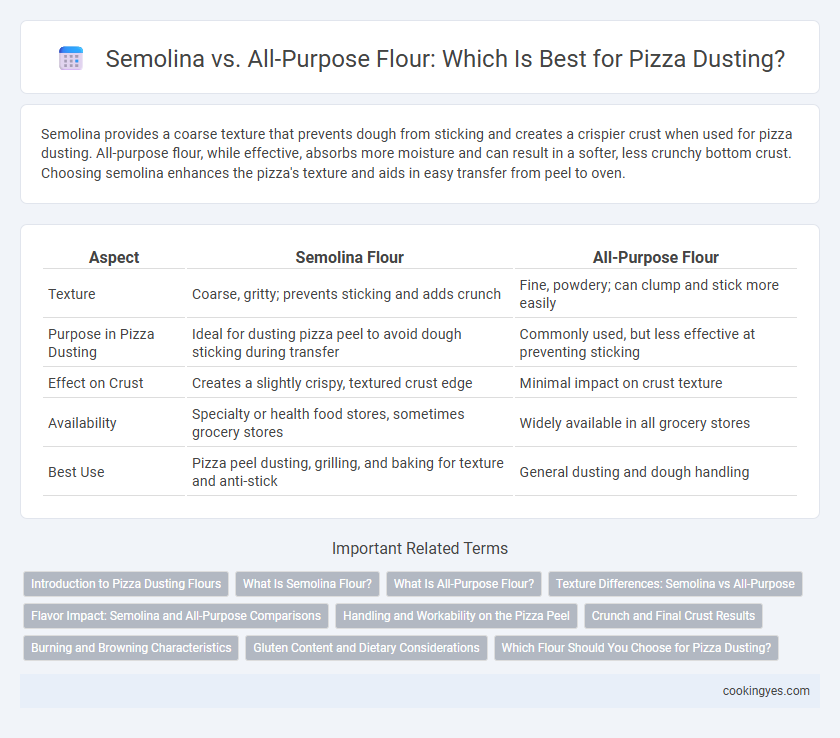Semolina provides a coarse texture that prevents dough from sticking and creates a crispier crust when used for pizza dusting. All-purpose flour, while effective, absorbs more moisture and can result in a softer, less crunchy bottom crust. Choosing semolina enhances the pizza's texture and aids in easy transfer from peel to oven.
Table of Comparison
| Aspect | Semolina Flour | All-Purpose Flour |
|---|---|---|
| Texture | Coarse, gritty; prevents sticking and adds crunch | Fine, powdery; can clump and stick more easily |
| Purpose in Pizza Dusting | Ideal for dusting pizza peel to avoid dough sticking during transfer | Commonly used, but less effective at preventing sticking |
| Effect on Crust | Creates a slightly crispy, textured crust edge | Minimal impact on crust texture |
| Availability | Specialty or health food stores, sometimes grocery stores | Widely available in all grocery stores |
| Best Use | Pizza peel dusting, grilling, and baking for texture and anti-stick | General dusting and dough handling |
Introduction to Pizza Dusting Flours
Semolina and all-purpose flour serve distinct roles in pizza dusting, impacting dough handling and crust texture. Semolina, coarser and more granular, prevents sticking with a slightly crunchy exterior, enhancing oven spring and providing a traditional Italian touch. All-purpose flour offers a fine, versatile grip without altering flavor, ideal for smooth dough release and consistent crust development.
What Is Semolina Flour?
Semolina flour is a coarse, gritty flour made from durum wheat, valued for its high protein and gluten content, which enhances dough strength and texture. It is commonly used for pizza dusting because its coarse grains prevent sticking without burning quickly, unlike finer all-purpose flour. Using semolina flour creates a crispier, more textured pizza crust, improving both handling and baking performance.
What Is All-Purpose Flour?
All-purpose flour is a versatile wheat flour blend commonly used for pizza dough preparation and dusting surfaces due to its moderate protein content of around 10-12%, which provides balanced gluten development. It offers a fine texture that prevents sticking without altering the dough's flavor or texture significantly. Compared to semolina, all-purpose flour creates a smoother surface, although it may absorb moisture differently, affecting the handling of pizza crust.
Texture Differences: Semolina vs All-Purpose
Semolina flour, made from durum wheat, provides a coarse, gritty texture that helps create a crispier and more substantial pizza crust by preventing dough from sticking. In contrast, all-purpose flour has a finer texture that offers less crunch but allows for a smoother, softer crust surface. Using semolina for dusting enhances the crust's structural integrity and adds a slight crunch, while all-purpose flour results in a more tender bite with minimal texture contrast.
Flavor Impact: Semolina and All-Purpose Comparisons
Semolina flour enhances pizza crust with a subtle nutty flavor and a slightly coarser texture, creating a distinct taste experience compared to the neutral profile of all-purpose flour. Using semolina for dusting adds a crunchy bite and golden appearance, while all-purpose flour provides a smoother, less pronounced flavor that allows toppings to stand out. Choosing between semolina and all-purpose flour impacts not only the flavor but also the crust's texture, making semolina ideal for those seeking a more robust, artisan-style pizza.
Handling and Workability on the Pizza Peel
Semolina flour's coarse texture provides superior grip on the pizza peel, reducing dough stickiness and allowing smoother, more controlled transfers. All-purpose flour, being finer, can clump and create resistance, potentially causing the dough to stick or tear during handling. For optimal workability and ease of sliding, semolina is preferred in professional pizza-making environments.
Crunch and Final Crust Results
Semolina flour provides a coarser texture for pizza dusting, resulting in a crunchier bottom crust with enhanced texture and non-stick properties. All-purpose flour creates a smoother surface with less crunch, often producing a softer, more pliable crust but may stick more during baking. Using semolina for dusting promotes a crisp, golden crust ideal for Neapolitan or Roman-style pizzas seeking a distinct crunch.
Burning and Browning Characteristics
Semolina flour's coarser texture resists burning better than all-purpose flour, producing a crisp and evenly browned pizza crust. All-purpose flour, with its finer granules, tends to burn quickly at high oven temperatures, leading to darker spots and potential bitterness. Using semolina for dusting enhances browning without compromising taste or texture, making it ideal for achieving a perfectly baked pizza base.
Gluten Content and Dietary Considerations
Semolina flour, with a gluten content averaging 12-14%, offers a coarser texture ideal for pizza dusting, preventing dough stickiness without absorbing moisture excessively. All-purpose flour contains slightly less gluten, around 10-12%, creating a smoother surface but potentially leading to dough adhering more during stretching. For dietary considerations, semolina is derived from durum wheat, which may pose gluten intolerance concerns, whereas all-purpose flour can sometimes be substituted with gluten-free blends for sensitive diets.
Which Flour Should You Choose for Pizza Dusting?
Semolina flour is coarser and provides excellent non-stick properties, creating a slightly crunchy texture on pizza crusts when used for dusting. All-purpose flour is finer and more common, offering a smoother surface but may cause dough to stick more during handling. Choosing semolina for pizza dusting enhances crispiness and reduces sticking, making it ideal for traditional Neapolitan and artisan-style pizzas.
Semolina vs All-purpose flour for pizza dusting Infographic

 cookingyes.com
cookingyes.com